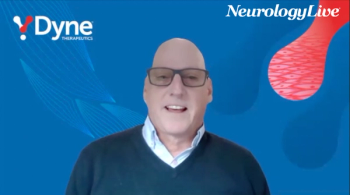
New Analyses Suggest High-Dose Aducanumab Reduces Clinical Decline in Early Alzheimer Disease
The data presentation from the phase 3 EMERGE and ENGAGE clinical trials suggest that aducanumab may result in disease-modifying effects, slowing clinical decline in those with early Alzheimer disease. Biogen expects to submit a BLA to the FDA for approval in early 2020.
Samantha Budd Haeberlein, PhD
Following
Although the results of the parallel ENGAGE trial showed no effect on clinical decline, post hoc analysis of a subset of patients exposed to high dose aducanumab hints toward support of the EMERGE findings. Additionally, substudies of the Biogen agent show an effect on Alzheimer-related biomarkers. The treatment is expected to be put forth in a biologics license application (BLA) to the FDA in early 2020.2
The data were presented by principal investigator Samantha Budd Haeberlein, PhD, vice president and head, Alzheimers Disease, Dementia, and Movement Disorders, Late Stage Clinical Development, Biogen, at the 12th Clinical Trials on Alzheimer’s Disease (CTAD) meeting, December 4-7, 2019 in San Diego, California. She noted that the group are finalizing the details of a re-dosing study with the aim to offer access to aducanumab to eligible patients previously enrolled in the aducanumab clinical studies.
“My feeling is sufficiently positive after a careful review of the full aducanumab program,” principal investigator Stephen Salloway, MD, MS, director, Neurology and the Memory and Aging Program, Butler Hospital, and professor of neurology, Warren Alpert Medical School, Brown University, said. “This could represent the first treatment that targets a core pathology and open an era of precision medicine for Alzheimer’s disease, and since use of the drug will require amyloid testing to determine who’s likely to benefit, it could also have the positive effect of leading to approval to amyloid PET, which would definitely benefit our patients.”
READ MORE:
Both trials included low-dose (EMERGE: n = 544; ENGAGE: n = 548) and high-dose (EMERGE: n = 547; ENGAGE: n = 558) arms compared to placebo (EMERGE: n = 548; ENAGE: n = 541).
In EMERGE, the difference in the change from baseline in Clinical Dementia Rating-Sum of Boxes (CDR-SB) was statistically significant in the high-dose group (change, —0.40 [23%]; P = .0101) compared to placebo. As well, significant differences were observed for the high dose compared to placebo in Alzheimer’s Disease Assessment Scale-Cognitive (ADAS-Cog 13) scores (change, —1.395 [27%]; P = .0098) and Alzheimer’s Disease Cooperative Study Activities of Daily Living scale for mild cognitive impairment (ADCS-ALD-MCI) scores (change, 1.7 [40%]; P = .0009).
“The ability to hold onto activities of daily living…if you think about a 40% reduction in decline on the ADCS-ADL-MCI, you’re talking about people at a mild stage of disease still being able to work, bank, shop, travel, enjoy leisure activities for longer—I submit to you that this matters a lot more to our patients than what score they get on a memory test,” principal investigator Sharon Cohen, MD, behavioral neurologist, University of Toronto, said. “I also believe that results on this functional scale of daily activity translates better to our nonspecialist colleagues in medicine, our family physicians who bear the brunt of Alzheimer’s care, as well as to the non-medical community who struggle to understand clinical meaningfulness.”
As for the relationship with biomarkers of the disease, the longitudinal change in amyloid positron emission tomography standard uptake value ratios (PET SUVR) was statistically significant at Week 78 in both studies. The EMERGE high-dose and low-dose groups experienced change of —0.272 and –0.165, respectively (P <.0001 for both) at a mean cumulative dose of 140 mg/kg, and the ENGAGE high-dose and low-dose groups experienced changes of —0.238 and –0.168, respectively (P <.0001 for both) at a cumulative dose of 126 mg/kg.
Additionally, findings related the cerebrospinal fluid (CSF) biomarkers of p-tau suggested a significant effect in both the high-dose group (n = 15; P <.001) and the low-dose group (n = 28; P <.05) compared to placebo (n = 22).
Summary of Phase 3
— Memory & Aging Program at Butler Hospital (@MemoryAndAging)
The overall safety of the EMERGE and ENGAGE trials suggested similar rates of adverse events (AEs) and serious AEs between placebo (Any AE: 87% and 86%, respectively; Serious AE: 14.1% and 12.8%, respectively) compared to the high-dose (Any AE: 92.3% and 89.6%, respectively; Serious AE: 12.1% and 12.7%, respectively) and low-dose (Any AE: 87.7% and 89.6%, respectively; Serious AE: 12.7% and 13%, respectively) groups.
The most common AE was ARIA-E, occurring at rates of 25.7% (n = 140) and 25.4% (n = 139) in the EMERGE and ENGAGE low-dose groups, respectively, and rates of 34% (n = 186) and 35.5% (n = 198) in the EMERGE and ENGAGE high-dose groups, respectively. Comparatively, the placebo group experienced respective ARIA-E rates of 2.2% (n = 12) and 3% (n = 16) in EMERGE and ENGAGE.
“From our PRIME study, we had shown that the greatest benefit was from 10 mg/kg, so going into these studies, we did believe that achieving that higher dose would be important for efficacy,” Budd Haeberlein explained. “But we did not have sufficient information on ARIA to be confident that we could take APOE4 carriers up to 10 mg/kg. It was when we received that data in August 2016 from the titration cohort in PRIME that titration itself did lower the incidence of ARIA in, exactly, APOE4 carriers.”
The supporting subgroup data from ENGAGE include the subpopulation of patients defined as the post-Protocol Version 4 (PV4) cohort, which consisted of patients who were both APOE4 positive and negative, all of whom received 14 doses of aducanumab at 10 mg/kg post-PV4 consent. Of the high-dose pre-PV4 patients, only 21% of EMERGE and 15% of ENGAGE received all 14 doses at the 10 mg/kg dose (mean cumulative dose, 116 mg/kg). Of the post-PV4 patients, 51% and 47% in EMERGE and ENGAGE, respectively, received the 14 full doses (mean cumulative dose, 153 mg/kg). Ultimately, the post-PV4 cohort in EMERGE included 295 low-dose, 288 high-dose, and 304 placebo patients, while ENGAGE included 261 low-dose, 282 high-dose, and 247 placebo patients.
The analysis of the post-PV4 cohort revealed similar results to the full intent-to-treat populations. For CDR-SB scores, compared to the high-dose difference of —0.40 (95% CI, –0.71 to –0.10) compared to placebo in EMERGE, the post-PV4 cohort showed a high-dose difference of –0.53 (95% CI, –1.05 to –0.02) compared to placebo. Likewise, in ENGAGE, after showing a difference of 0.03 (95% CI, –0.26 to 0.33) for the high dose for the intent-to-treat population, in the post-PV4 population, the difference was –0.48 (95% CI, –1.02 to 0.06).
“I would not recommend changing dose in the middle of a phase 3 trial, but it did turn out to be important for this particular study, and if we had not done so, we would not have the results that we have today. We knew dose was important and we made those changes to get to that dose,” Budd Haeberlein said.
"My feeling is sufficiently positive after careful review of the full
— Memory & Aging Program at Butler Hospital (@MemoryAndAging)
Notably, some concern has arisen regarding the findings of these trials, including an editorial published in The Lancet Neurology by Lon Schneider, MD, professor of psychiatry, neurology, and gerontology, Keck School of Medicine, University of Southern California.3 Schneider pointed to the previously sparse available information from Biogen investors conference, noting that, “although Biogen claims that the positive results of the EMERGE trial were driven by greater exposure to a higher dose in the larger dataset, the effect could just as likely been due to greater worsening in the placebo group.”
Schneider also pointed to the framing of the trials as suspect, with EMERGE deemed positive and ENGAGE deemed negative, though with subset analysis supporting the findings of EMERGE—which the FDA might accept as meeting its regulatory criteria for “substantial evidence of effectiveness,” defined as “one adequate and well-controlled study and additional confirmatory evidence.”
“The study was terminated early, and the dose was increased for a large number of participants. We know that dose matters for this drug—probably with this class—and there was a substantial dose-related lowering of plaque with positive results across all of the outcomes for one study and not the other, but continued exposure to high dose benefitted patients with early Alzheimer disease," Salloway said. "This fits with our experience. We need to drill down and understand who is the most likely to respond.”
Maria C. Carrillo, PhD, chief science officer, Alzheimer’s Association, called the report an important moment for the field, noting that the Alzheimer’s Association looks forward to learning the results of the forthcoming FDA review of aducanumab.4
“If the FDA approves this drug for the treatment of Alzheimer’s, our expectation is that everyone for whom the drug was demonstrated to be beneficial will have access to treatment as soon as possible,” Carrillo said in a statement. “No stone can be left unturned. The Alzheimer’s Association believes we must advance all potential treatment avenues, and explore methods for combining approaches that are proven to be successful.”
Aducanumab is a human monoclonal antibody that selectively targets aggregated forms of amyloid-beta, including both soluble oligomers and insoluble fibrils. Since 2017, Biogen and Eisai have collaborated on the development and commercialization of the agent, which was previously granted fast track designation by the FDA. The drug was examined in patients with early-stage Alzheimer disease, including mild cognitive impairment and mild Alzheimer dementia.
REFERENCES
1. Budd Haeberlein S, von Hehn C, Tian Y, et al. EMERGE and ENGAGE Topline Results: Two Phase 3 Studies to Evaluate Aducanumab in Patients With Early Alzheimer’s Disease. Presented at: 12th Annual CTAD Meeting; December 4-7, 2019; San Diego, CA.
2. Biogen Plans Regulatory Filing for Aducanumab in Alzheimer’s Disease Based on New Analysis of Larger Dataset from Phase 3 Studies [news release]. Cambridge, MA and Tokyo: Biogen and Eisai. October 22, 2019. biospace.com/article/releases/biogen-plans-regulatory-filing-for-aducanumab-in-alzheimer-s-disease-based-on-new-analysis-of-larger-dataset-from-phase-3-studies. Accessed December 5, 2019.
3. Schneider L. A resurrection of aducanumab for Alzheimer's disease. Lancet Neurol. Published online December 4, 2019. doi: 10.1016/S1474-4422(19)30480-6.
4. Alzheimer’s Association Statement Biogen Report of Phase 3 Aducanumab Data at CTAD 2019 [press release]. Chicago, IL: Alzheimer’s Association; Published December 5, 2019. alz.org/news/2019/alzheimer-s-association-statement-biogen-report-of. Accessed December 5, 2019.
Newsletter
Keep your finger on the pulse of neurology—subscribe to NeurologyLive for expert interviews, new data, and breakthrough treatment updates.



































